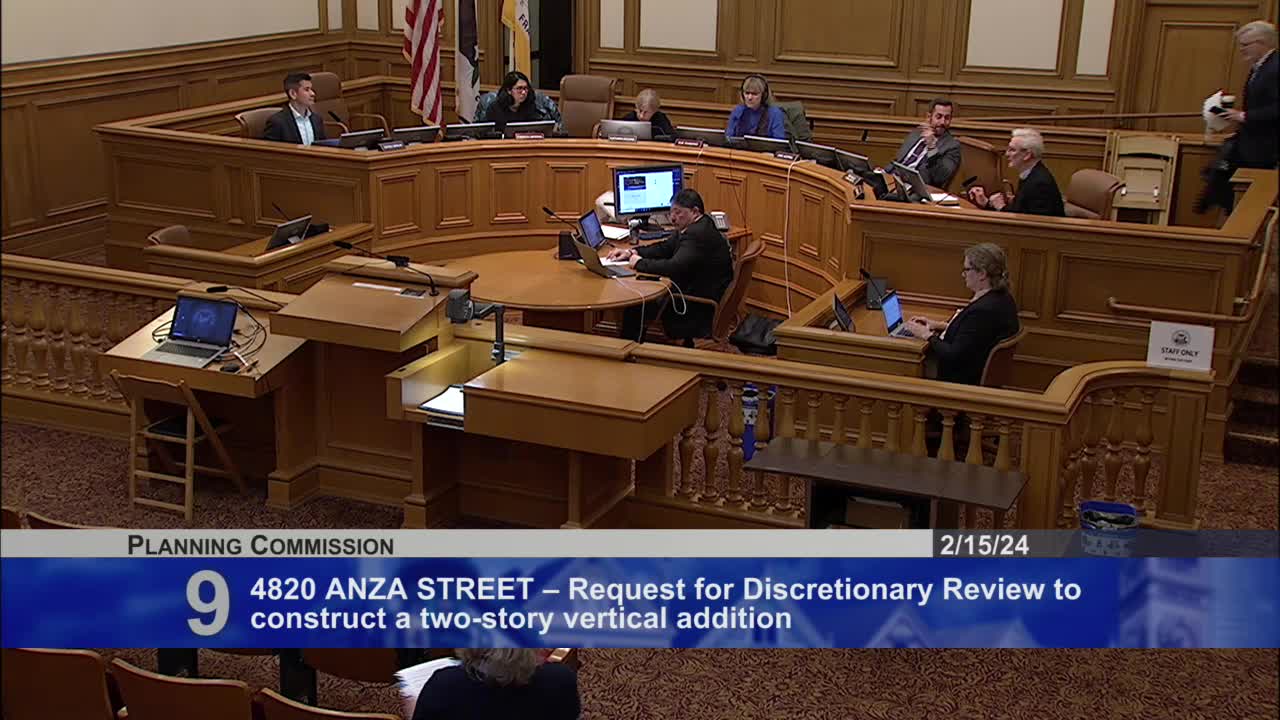San Francisco committee reviews vertical addition proposal at Ninth Avenue home
February 15, 2024 | San Francisco City, San Francisco County, California

This article was created by AI summarizing key points discussed. AI makes mistakes, so for full details and context, please refer to the video of the full meeting. Please report any errors so we can fix them. Report an error »

In a recent San Francisco government meeting, city officials discussed a public request for a discretionary review of a building permit application aimed at constructing a two-story vertical addition to a single-family home located at 58730 Ninth Avenue. The existing structure, built in 1924, is classified as a Category C building with no historic designation. The proposal has sparked community interest, evidenced by two letters of support and three letters of opposition.
The primary concerns raised by the opposing residents, represented by Deborah Holly on behalf of the Katz family, center around compliance with residential design guidelines. They argue that the proposed addition does not adequately consider the building's scale, topography, and the impacts on privacy and light for neighboring properties. The Katz family has suggested alternatives, including the removal of the proposed fourth story and the rear roof deck, to better align the project with the neighborhood's character.
City staff, led by architect David Winslow, expressed general support for the project, noting that it complies with existing codes and design guidelines. Winslow highlighted that the design has been adjusted to reduce the massing at the rear by setting back the third and fourth stories, which he believes makes it compatible with the surrounding structures. He clarified that the addition's height appears less imposing due to the high parapets of adjacent buildings, making it visually similar to the existing three-story homes in the area.
During the public comment portion, Rita and Eugene Katz, residents of the adjacent property, emphasized their commitment to preserving the neighborhood's character. They argued that the proposed addition would significantly alter the look and feel of the area, which they believe should remain predominantly two stories. They proposed that the project could still achieve its goals without the fourth story, suggesting that the office and bathroom planned for that level could be relocated within the existing structure.
The discussion also touched on the evolving nature of the discretionary review process, indicating that changes may be forthcoming in how such projects are evaluated in the future. As the meeting concluded, the commissioners were left to weigh the community's concerns against the project's compliance with city regulations.
This meeting underscores the ongoing tension in San Francisco between development and community preservation, as residents advocate for maintaining the character of their neighborhoods while developers seek to expand and modernize existing structures. The outcome of this review could set a precedent for future projects in similar residential areas.
The primary concerns raised by the opposing residents, represented by Deborah Holly on behalf of the Katz family, center around compliance with residential design guidelines. They argue that the proposed addition does not adequately consider the building's scale, topography, and the impacts on privacy and light for neighboring properties. The Katz family has suggested alternatives, including the removal of the proposed fourth story and the rear roof deck, to better align the project with the neighborhood's character.
City staff, led by architect David Winslow, expressed general support for the project, noting that it complies with existing codes and design guidelines. Winslow highlighted that the design has been adjusted to reduce the massing at the rear by setting back the third and fourth stories, which he believes makes it compatible with the surrounding structures. He clarified that the addition's height appears less imposing due to the high parapets of adjacent buildings, making it visually similar to the existing three-story homes in the area.
During the public comment portion, Rita and Eugene Katz, residents of the adjacent property, emphasized their commitment to preserving the neighborhood's character. They argued that the proposed addition would significantly alter the look and feel of the area, which they believe should remain predominantly two stories. They proposed that the project could still achieve its goals without the fourth story, suggesting that the office and bathroom planned for that level could be relocated within the existing structure.
The discussion also touched on the evolving nature of the discretionary review process, indicating that changes may be forthcoming in how such projects are evaluated in the future. As the meeting concluded, the commissioners were left to weigh the community's concerns against the project's compliance with city regulations.
This meeting underscores the ongoing tension in San Francisco between development and community preservation, as residents advocate for maintaining the character of their neighborhoods while developers seek to expand and modernize existing structures. The outcome of this review could set a precedent for future projects in similar residential areas.
View full meeting
This article is based on a recent meeting—watch the full video and explore the complete transcript for deeper insights into the discussion.
View full meeting
